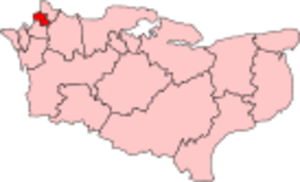Bexley (UK Parliament constituency) facts for kids
Quick facts for kids {{{Name}}}[[{{{Type}}} constituency]] |
|
|---|---|
| [[Image:{{{Map1}}}Constituency.svg|120px|]] [[Image:England{{{Map2}}}.svg|120px|]] |
|
| {{{Name}}} shown within [[{{{Entity}}}]], and {{{Entity}}} shown within England | |
| Created: | {{{Year}}} |
| MP: | {{{MP}}} |
| Party: | {{{Party}}} |
| Type: | House of Commons |
| County: | [[{{{County}}}]] |
| EP constituency: | [[{{{EP}}} (European Parliament constituency)|{{{EP}}}]] |
Bexley was a special area in south-east London that had its own representative in the Parliament of the United Kingdom. This area is called a parliamentary constituency.
People living in Bexley would vote for one person to be their Member of Parliament (MP). This MP would then speak for Bexley in the House of Commons.
Contents
History of Bexley's Parliament Seat
The Bexley parliamentary area was created for the general election in 1945. It was made from parts of two other areas: Chislehurst and Dartford.
This special voting area was later removed for the 1974 general election. Instead, two new areas were created: Bexleyheath and Sidcup.
The borders of the Bexley voting area were the same as the borders of the Municipal Borough of Bexley.
A very famous MP for Bexley was Edward Heath. He was the Prime Minister of the UK at the time the Bexley constituency was abolished. He then became the MP for the new Sidcup area in 1974. Later, he represented another new area called Old Bexley and Sidcup from 1983. He was an MP for 50 years before he retired in 2001!
Who Represented Bexley?
Here are the people who were elected as the Member of Parliament for Bexley:
| Election | Member | Party | Notes | |
|---|---|---|---|---|
| 1945 | Jennie Adamson | Labour | She was an MP for Dartford before this. She left her role in 1946. | |
| 1946 by-election | Ashley Bramall | Labour | ||
| 1950 | Rt Hon Edward Heath | Conservative | He became the leader of the Conservative Party (1965–1975) and Prime Minister (1970–1974). After Bexley, he became the MP for Sidcup. | |
| Feb 1974 | The Bexley voting area was removed. See Bexleyheath and Sidcup for new areas. | |||
Voting Results in Bexley
People in Bexley voted in several general elections and one special by-election. These elections decided who would represent them in Parliament.
1940s Elections
In the 1945 election, Jennie Adamson from the Labour Party won. She received 24,686 votes. The Conservative candidate, John Lockwood, got 12,923 votes.
After Jennie Adamson resigned, a special election called a by-election was held in 1946. Ashley Bramall from the Labour Party won this election with 19,759 votes.
1950s Elections
In the 1950 election, Edward Heath from the Conservative Party won by a very small number of votes! He got 25,854 votes, just 133 more than the Labour candidate, Ashley Bramall. This was a big change, as the Conservatives gained the seat from Labour.
Edward Heath won again in the 1951 election, increasing his lead. He continued to win in the 1955 and 1959 elections, showing strong support for him and the Conservative Party in Bexley.
1960s Elections
Edward Heath continued to be the MP for Bexley throughout the 1960s. He won the 1964 election and the 1966 election. His winning margin, which is the difference in votes between him and the next candidate, became smaller in these elections.
1970 Election
In the 1970 election, Edward Heath won again. He received 27,075 votes, which was a good lead over the Labour candidate, John Cartwright. This was the last time Bexley voted as a single constituency before it was divided into new areas.


